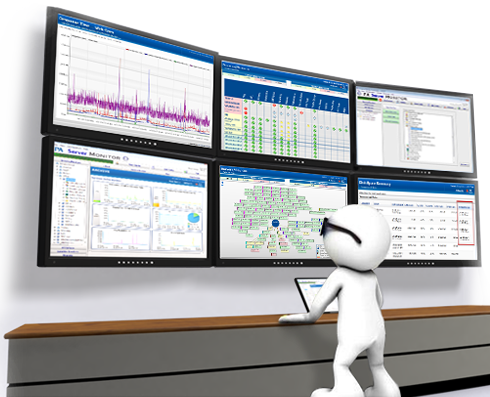
Monitoring Dedicated Servers – For some clients, brief periods of time when their website may go offline are tolerable as many of those are due to scheduled maintenance of the hosting provider’s infrastructure, but for others any downtime adversely affects their businesses, especially in today’s global marketplace.
How would you know if your website went offline?
The wrong way to find out your website is offline is to start getting phone calls from your clients trying to place or track their orders – telling you that they can’t log into your site. The better way is to set up system monitoring services that send you email or text notifications when something goes awry. It’s critically important on e-commerce sites to have an updated status of your network each and every minute. Why? Quick reaction time to resolving whatever the issue is with your site relates to minimum client service disruptions.
The basics of system monitoring services
System monitoring services offer a myriad of solutions, for everything from the smallest of sites to the most complex of servers and networks. A recent Google query for “system monitoring services” returned over five million results, so if you’re watching just one server or many times that, there’s a package out there to simplify your management efforts, all in real time.
Exactly what can these monitoring packages track?
Yes, there are some free packages, as well as packages that can monitor your entire infrastructure. Most of the commercial packages track a large number of services, including; FTP, MySQL, SSH, RTSP streaming media, HTTP, POP, IMAP, SMTP, ICMP ping and PostgreSQL (and others).
How often do these monitors normally track those services?
The lower end (FREE) system monitoring services typically monitor in fifteen minute intervals, but more options are available with higher priced solutions. Typically, those options will include; shorter interval times, multiple monitoring locations, filtering of web page content, monitoring of pings, alert failures, error details, multiple alert contacts (in case you want someone else to know your site is down, like the owner or IT manager), custom time zones, statistics available online, monthly reports and so on.
When selecting what package to pursue, first evaluate your website and infrastructure requirements.
If your website is simply an informational site that rarely updates, then a lower end solution will work just fine, but as your online presence becomes more and more complex, you’ll need to evaluate higher end system monitoring packages. If you’re posting dynamic content on your sites coming from more than one source, the right package can make a huge difference. You also need to look at your backend web services. Do you offer chat on your sites? What about email services?
What are some of the other options available?
- How far you can go back on the statistics of alerts – If you’re looking at FREE monitoring service, those will normally only be archived for a few months, if that. With higher end system monitoring services, those can be archived indefinitely.
- Optional failover monitoring – is designed to withstand failure of single components, such that another node will kick in automatically to maintain uninterrupted monitoring of your services.
- Intelligent services – are services that are designed to intelligently monitor your online presence. Sometimes, those indicators can amount to 15 or more critical services.
What else can these packages do for you?
They can help you figure out if your hosting provider is living up to their Service Level Agreement (SLA), because some of them won’t tell you when your site is down.
- You can use the reports to extract marketing and sales information.
- You can even use them to extract information about your competitors.
Back to disaster recovery and business continuity
I constantly write to the importance of disaster recovery and business continuity plans. System monitoring services are an integral component of that solution. As a side note, there can be false positives, meaning you’ll get an alert even though nothing is actually down, but those alerts have diminished over the years with updates to most packages. The bottom line is that it’s better to be safe than sorry.
BROUGHT TO YOU BY PROLIMEHOST
We’ve been in the web hosting industry for over a decade, helping hundreds of clients succeed in what they do best and that’s running their business. We specialize in Virtual Private Servers (VPS) and dedicated servers, with data centers in Los Angeles, Denver & Singapore.
VPS SERVICES: LIGHTNING FAST SSD VIRTUAL SERVERS
Our Virtual Private Servers all feature high performance Xeon processors and SSD storage in a RAID10 configuration to optimize your server’s performance, which dramatically enhances visitor experiences on your site.
That speed is backed by unparalleled 24/7 support, featuring both outstanding response AND resolution times to maximize your uptime.
Now is the time to join the ProlimeHost virtual private server revolution.
DEDICATED SERVERS: BACKED BY A 99.9% SLA NETWORK UPTIME GUARANTEE
We only use enterprise-class hardware in our dedicated servers and offer a four (4) hour hardware replacement. Throw in IPMI for remote management, support for public and private networks, free operating system (OS) re-installs, and SATA, SAS & SSD (including NVMe) storage. Call 1-877-477-9454 or contact us. For everything from gaming servers to cheap dedicated servers, we’re here to help.
ASIA OPTIMIZED SERVERS: IMPROVING CONNECTION SPEED AND QUALITY
Procuring an Asia optimized server improves the connection speed and quality between the server and the users in Asia or China. This can reduce latency, packet loss, jitter, and bandwidth issues that can affect the performance and reliability of the server and the applications hosted on it. For more information, please call 1-877-477-9454 or contact us
- Dedicated Server or VPS? Which is better? - April 25, 2025
- Which RAID solution do you need? - April 24, 2025
- Dedicated Server Suggestions - April 23, 2025




